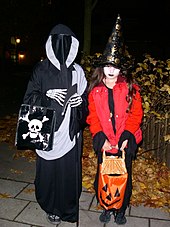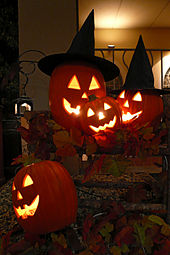

Halloween is also thought to have been heavily influenced by the Christian holy days of All Saints' Day (also known as Hallowmas, All Hallows, Hallowtide) and All Souls' Day. Falling on November 1st and 2nd respectively, collectively they were a time for honoring the Saints and praying for the recently departed who had yet to reach heaven. By the end of the 12th century they had become days of holy obligation across Europe and involved such traditions as ringing bells for the souls in purgatory and "souling", the custom of baking bread or soul cakes for "all crysten [christened] souls".
In Britain the rituals of Hallowtide and Halloween came under attack during the Reformation as protestantsdenounced purgatory as a "popish" doctrine incompatible with the notion of predestination. In addition the increasing popularity of Guy Fawkes Night from 1605 on saw Halloween become eclipsed in Britain with the notable exception of Scotland.Here, and in Ireland, they had been celebrating Samhain and Halloween since the early Middle Ages, and it is believed the Kirk took a more pragmatic approach towards Halloween, viewing it as important to the life cycle and rites of passage of local communities and thus ensuring its survival in the country.
North American almanacs of the late eighteenth and early nineteenth century give no indication that Halloween was recognized as a holiday. The Puritansof New England, for example, maintained strong opposition to the holiday and it was not until the mass Irish and Scottish immigration during the 19th century that the holiday was introduced to the continent in earnest. Initially confined to the immigrant communities during the mid-nineteenth century, it was gradually assimilated into mainstream society and by the first decade of the twentieth century it was being celebrated coast to coast by people of all social, racial and religious backgrounds.
Symbols
The imagery of Halloween is derived from many sources, including national customs, works of Gothic and horror literature (such as the novels Frankenstein and Dracula), and classic horror films (such as Frankenstein and The Mummy).Among the earliest works on the subject of Halloween is from Scottish poet John Mayne in 1780, who made note of pranks at Halloween; "What fearfu' pranks ensue!", as well as the supernatural associated with the night, "Bogies" (ghosts), influencing Robert Burns' Halloween 1785. Elements of the autumn season, such as pumpkins, corn husks, andscarecrows, are also prevalent. Homes are often decorated with these types of symbols around Halloween.
Halloween imagery includes themes of death, evil, the occult, or mythical monsters.[18] Black and orange are the holiday's traditional colors.
ไม่มีความคิดเห็น:
แสดงความคิดเห็น